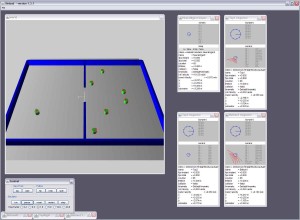Then we could run it in about 50 atoms worth of space. That is assuming that we could build the smallest state machine possible in that amount of space and then actually wire it up to some tiny interface. The smallest possible universal state machine was proven to exist a couple days ago by Alex Smith of Birmingham, UK.
This really does have some significant impact. While I don’t think we would run the algorithm for intelligence on this particular state machine, we could. We could in fact run any program at all on this state machine and have it input and output any possible string of information. You can think of this as the smallest possible independent microprocessor. This could be a significant step in the advancement of massively parallel sensor networks.
Think of this, you construct a piece of e-paper made up of these tiny little state machines. You connect them in all eight directions to their neighbours using carbon nanotube circuitry as well as connecting the top layer to a set of output machines, something like a pixel in an LCD. Now put a few of these together into a magazine and put some somewhat more complex circuitry into the spine of the book along with a power source (probably an external layer of solar energy molecules) and you have yourself an extremely powerful parallel computer that looks something like a book but is capable of far more. Completely dynamic content all controlled through a massively distributed network of basic microprocessor state machines. I can’t take credit for this idea, it is from “The Diamond Age” a very good novel about nanotechnology but what is fantastic in that book is a step closer to reality due to this proof and several recent advances in nanotechnology. Another common theme from the same book is how ubiquitous these massively parallel systems could be. They could consist of countless billions of tiny sensor nodes distributed through the air. You could breathe them in without destroying significant portions of the network because they are so small (about the size of dust). Yet the processing power in each is universal and the power of the entire system is extraordinary. Each of the nodes could perform complex sensing tasks and transmit their information through the network back to their home base. These truly would be automatons adrift!
Of course the algorithms to do that efficiently don’t really exist yet, but they are being worked on.
I know it seems pretty wild, but that is just one example. When you distribute the processing of a program across millions of tiny universal state machines you can drop the time to process down to a much smaller value. This would require a completely new direction in programming but it is entirely possible. The original posting of this was found on slashdot, thanks guys!
